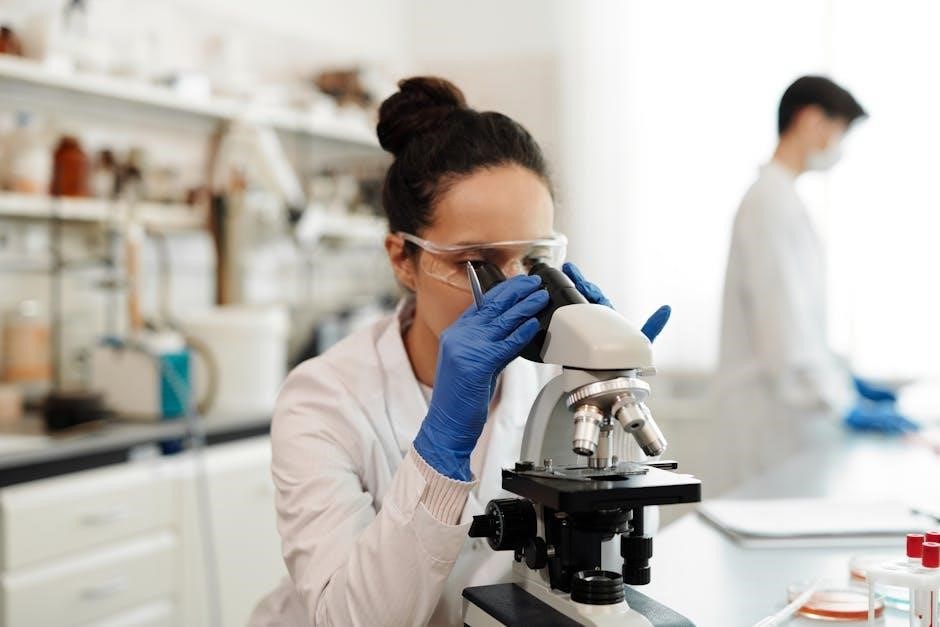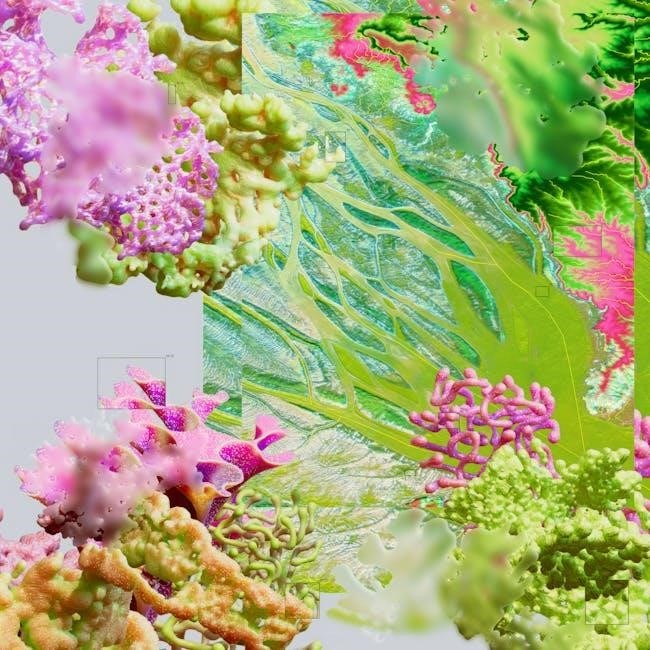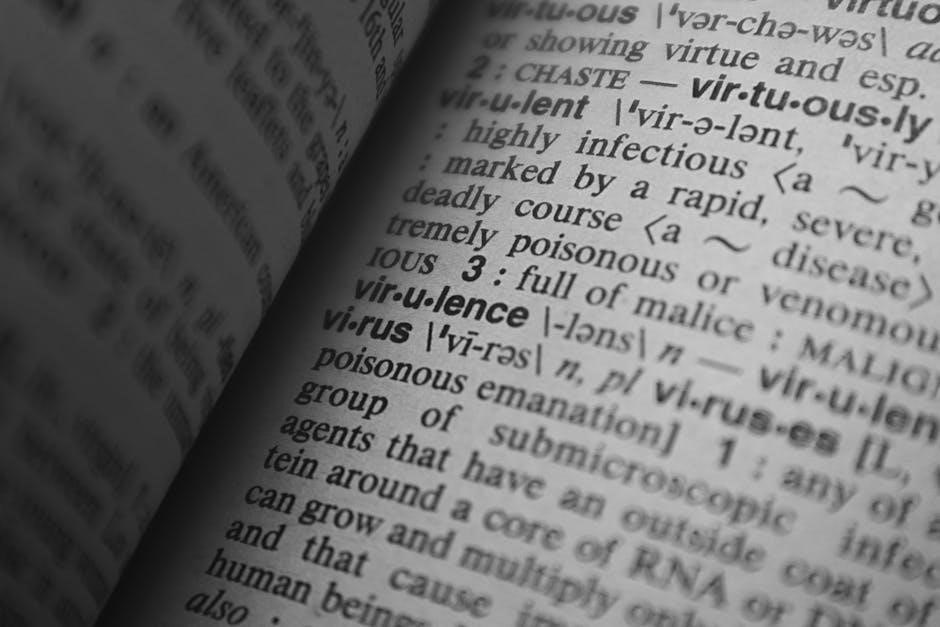
Microbiology is the scientific study of microorganisms, including bacteria, viruses, fungi, and parasites. These tiny life forms have profound impacts on human health, the environment, and biotechnology. Understanding microbiology is essential for combating infectious diseases, developing vaccines, and harnessing microbial potential in industries. This textbook introduces the fundamentals of microbiology, exploring microbial structures, genetics, and interactions with their ecosystems. It serves as a foundation for students and professionals seeking to explore the microbial world and its applications.

Importance of Studying Microbiology
Studying microbiology is crucial for understanding the intricate roles microorganisms play in human health, the environment, and various industries. Microorganisms, though often invisible to the naked eye, are foundational to life on Earth, influencing ecosystems, disease processes, and biotechnological advancements. By exploring microbiology, scientists gain insights into how microbes contribute to infections, immune responses, and the development of vaccines and antibiotics. This knowledge is vital for combating infectious diseases, which remain a significant global health challenge.
Microbiology also holds immense importance in environmental science. Microbes are key players in nutrient cycling, waste decomposition, and pollution control. Their ability to degrade toxic substances makes them indispensable in cleaning up contaminated sites. Additionally, microbiology informs agricultural practices, as certain microbes enhance soil fertility and plant growth, reducing the need for chemical fertilizers.
In the industrial sector, microbiology drives innovation in food production, pharmaceuticals, and biotechnology. Fermentation processes, for example, rely on microbial activity to produce goods like yogurt, cheese, and alcohol. Similarly, microbes are engineered to manufacture enzymes, biofuels, and other valuable compounds. Understanding microbial genetics and metabolism is essential for these applications.
Furthermore, microbiology provides a foundation for advanced fields like genetic engineering and molecular biology. The discovery of microbial enzymes, such as restriction endonucleases, has revolutionized DNA manipulation techniques. This underscores the broader impact of microbiology on scientific progress and technological development.

Key Features of a Good Microbiology Textbook
A good microbiology textbook should be comprehensive, well-organized, and accessible to students at various levels of understanding. It should provide a clear introduction to the fundamentals of microbiology, including the history, key concepts, and methodologies used in the field. The textbook should also incorporate detailed explanations of microbial structures, metabolism, genetics, and interactions with hosts and environments.
One of the most important features is the inclusion of high-quality visual aids, such as diagrams, micrographs, and illustrations, to help students visualize complex processes like cellular structures, metabolic pathways, and laboratory techniques. These visuals should be accompanied by clear captions and legends to enhance understanding. Additionally, the textbook should include case studies or real-world examples to illustrate the practical applications of microbiology in medicine, agriculture, and environmental science.
A good microbiology textbook should also emphasize critical thinking and problem-solving skills. This can be achieved through the inclusion of review questions, discussion points, and laboratory exercises. Many modern textbooks now offer supplementary materials, such as online resources, interactive simulations, and downloadable study guides, which can significantly enhance the learning experience.
Another key feature is the ability to stay updated with the latest scientific discoveries and advancements. Microbiology is a rapidly evolving field, with new research emerging regularly on topics like the human microbiome, antimicrobial resistance, and emerging infectious diseases. A textbook that incorporates these updates ensures that students receive current and relevant information.
Finally, a good microbiology textbook should be written in a clear, concise, and engaging manner, avoiding unnecessary jargon while still maintaining scientific accuracy. The inclusion of a comprehensive glossary of terms and a detailed index further enhances its usability. By combining these features, a microbiology textbook can serve as an invaluable resource for students, researchers, and professionals alike.

Popular Microbiology Textbooks
There are several widely recognized and respected microbiology textbooks that are popular among students, educators, and professionals. One of the most notable is “A Textbook Of Microbiology” by Ananthanarayan, which provides a comprehensive overview of the subject, including fundamental concepts, bacterial culture techniques, staining methods, and the history of microbiology. This textbook is known for its detailed appendices, which include metabolic pathways, taxonomy, and a glossary of terms, making it a valuable resource for both beginners and advanced learners.
Another popular choice is “Microbiology” by Linda Bruslind, which is licensed under a Creative Commons Attribution-NonCommercial 4.0 International License. This open-access textbook is designed for students in microbiology, biology, and allied health fields, offering a balanced approach that combines essential concepts with cutting-edge research. It covers topics such as microbial evolution, ecology, and the human microbiome, making it a versatile and up-to-date resource.
For those seeking practical applications, “Microbiology for Allied Health Students” is an excellent option. This textbook focuses on the fundamental concepts of microbiology with a strong emphasis on their relevance to careers in the health field. It is particularly useful for students in nursing, dental hygiene, and other allied health professions.
Additionally, “General Microbiology” by Linda Bruslind is another highly regarded textbook that provides a thorough introduction to the subject. It is supported by grant funding from Oregon State University Ecampus and is available as an open educational resource. The textbook is known for its clarity and accessibility, making it ideal for students who are new to the field.
Other notable mentions include “Benson’s Microbiological Applications,” which has long been a standard in microbiology education, and “Microbiology” by Joanne Willey, Linda Sherwood, and Chris Woolverton, which offers a balanced and comprehensive introduction to all major areas of microbiology. These textbooks are widely used in academic settings and are available in both print and digital formats, including PDF versions for easy access.
Overall, these popular microbiology textbooks provide a solid foundation for understanding the subject, catering to the needs of students, researchers, and professionals alike. Their availability in digital formats, such as PDF, makes them easily accessible to a global audience.

Authors and Their Contributions
The field of microbiology has been shaped by the contributions of numerous authors who have dedicated their expertise to creating comprehensive and accessible textbooks. One of the most prominent authors in microbiology is Ananthanarayan, known for his seminal work “A Textbook Of Microbiology”. This textbook is widely acclaimed for its detailed coverage of microbial physiology, taxonomy, and immunology, making it a cornerstone for both undergraduate and postgraduate studies. Ananthanarayan’s work is particularly praised for its clarity and the inclusion of essential appendices that provide supplementary information on metabolic pathways and glossaries of terms.
Another notable contributor is Linda Bruslind, who has authored several influential microbiology textbooks, including “General Microbiology” and “Microbiology for Allied Health Students”. Bruslind’s textbooks are renowned for their balanced approach, blending fundamental concepts with cutting-edge research. Her work is particularly valued for its emphasis on microbial ecology and the human microbiome, offering students a modern perspective on the field. Additionally, her textbooks are supported by grant funding from Oregon State University Ecampus, ensuring their accessibility to a broad audience.
Joanne Willey, Linda Sherwood, and Chris Woolverton are also prominent authors in the field, having co-authored the widely used textbook “Microbiology”. Their work provides a comprehensive introduction to all major areas of microbiology, including microbial genetics, cell structures, and the role of microorganisms in human health and disease. The textbook is appreciated for its clear organization and the inclusion of bibliographical references, making it a valuable resource for both students and researchers.
These authors, along with others, have played a crucial role in advancing microbiology education by creating textbooks that are both informative and engaging. Their contributions have helped shape the understanding of microorganisms and their significance in various fields, from medicine to biotechnology. By providing high-quality educational resources, these authors continue to inspire future generations of microbiologists and scientists.

Digital Resources and Online Availability
The advent of digital technology has revolutionized access to microbiology textbooks, with numerous resources now available online in PDF format. Websites like InfoBooks and OpenStax offer free downloadable textbooks, making high-quality educational materials accessible to students worldwide. These digital resources are particularly beneficial for those in remote or resource-limited areas, ensuring equitable access to microbiology education.
Popular microbiology textbooks, such as “A Textbook Of Microbiology” by Ananthanarayan and “General Microbiology” by Linda Bruslind, are available for download in PDF format. These texts are enriched with detailed appendices, glossaries, and indices, providing students with comprehensive study aids. Additionally, platforms like Digital Library of India host classic and contemporary microbiology texts, preserving knowledge for future generations.
Beyond full textbooks, supplementary materials such as MCQs, lab manuals, and lecture notes are also available online. For instance, “Mcqs in Microbiology” by Mohammed Bilal is a popular resource for exam preparation. These digital tools cater to diverse learning needs, offering interactive and self-assessment features that enhance the learning experience.
The shift to digital resources has also enabled the integration of multimedia elements, such as hyperlinks to additional reading, videos, and interactive diagrams. This enhances the understanding of complex microbial concepts and provides a more engaging learning experience. Furthermore, digital textbooks are often updated regularly, ensuring that students have access to the latest research and advancements in microbiology.

Specialized Topics in Microbiology Textbooks
Modern microbiology textbooks often include specialized topics that cater to the diverse applications and advancements in the field. These topics are designed to provide in-depth knowledge beyond the foundational concepts, enabling students and researchers to explore niche areas of interest. One such specialized topic is microbial genetics, which delves into the mechanisms of genetic transfer, mutation, and recombinant DNA technology. This section is crucial for understanding how microorganisms adapt to environments and develop resistance to antibiotics.
Another key area is microbial ecology, which examines the interactions between microorganisms and their environments. This topic is particularly relevant for understanding ecosystems, bioremediation, and the role of microbes in climate change. Some textbooks, such as the Canadian edition of A Textbook Of Microbiology, include dedicated chapters on applied microbiology, highlighting its practical implications in agriculture, industry, and environmental science.
The human microbiome is another specialized topic gaining prominence in microbiology textbooks. This section explores the complex relationships between microbes and human health, including their roles in digestion, immunity, and disease. Textbooks now emphasize the latest research on how imbalances in the microbiome, or dysbiosis, contribute to conditions like obesity, diabetes, and mental health disorders.
Additionally, many textbooks incorporate chapters on industrial microbiology, focusing on the production of antibiotics, vaccines, and bioactive compounds. This area underscores the economic and technological significance of microorganisms in biotechnology and pharmaceutical industries. Some texts also address emerging fields like synthetic biology and CRISPR technology, showcasing the cutting-edge applications of microbiological research.
These specialized topics not only enhance the depth of microbiology education but also prepare students for advanced research and professional challenges. By integrating these areas, textbooks provide a comprehensive understanding of microbiology’s vast and dynamic landscape.

Applied Fields of Microbiology
Microbiology, as a discipline, extends far beyond theoretical knowledge, offering practical applications across various industries and fields. These applied fields are essential for addressing real-world challenges, from human health to environmental sustainability. One of the most prominent applied fields is medical microbiology, which focuses on understanding and combating infectious diseases. This field is crucial for developing diagnostics, vaccines, and treatments, as highlighted in textbooks like Microbiology for Allied Health Students.
Environmental microbiology is another critical area, exploring the roles of microorganisms in ecosystems, bioremediation, and climate change. Textbooks often emphasize how microbes can clean up pollutants and maintain ecological balance. For instance, certain bacteria can degrade oil spills, while others contribute to nutrient cycling in soils.
The food and beverage industry relies heavily on microbiology to ensure safety and quality. Microbiologists work to prevent spoilage, detect pathogens, and develop fermentation processes for products like yogurt, cheese, and beer. Textbooks such as General Microbiology by Linda Bruslind provide detailed insights into food microbiology, including the use of preservatives and packaging techniques.
Agricultural microbiology focuses on improving crop yields and soil fertility through microbial interventions. This includes the use of biofertilizers and pest control agents. Textbooks like A Textbook Of Microbiology by Ananthanarayan discuss how microbes can enhance plant growth and reduce reliance on chemical inputs.
Lastly, public health microbiology plays a vital role in tracking and controlling infectious disease outbreaks. By monitoring water, air, and food supplies, microbiologists help prevent epidemics and promote community health. This field is increasingly important in the context of global health challenges.
These applied fields demonstrate the versatility and importance of microbiology in solving practical problems. By integrating theoretical knowledge with real-world applications, microbiology textbooks equip students and professionals to address diverse challenges across industries.

Study Aids and Supplementary Materials
Supplementary materials are essential for enhancing the learning experience in microbiology. Many textbooks, such as A Textbook Of Microbiology by Ananthanarayan, include appendices with fundamental concepts like metabolic pathways, taxonomy, and mathematical basics. These resources help students grasp complex topics and apply theoretical knowledge practically. Additionally, glossaries and indices of terms and symbols are invaluable for quick reference, ensuring clarity and ease of navigation.
Multiple-choice questions (MCQs) are another popular study aid, as seen in resources like MCQs in Microbiology by Mohammed Bilal. These questions test comprehension and prepare students for exams, reinforcing key concepts. Laboratory manuals, such as Exercises: Microbiology (Kaiser) and Introductory Bacteriology Lab Manual (Turnbull), provide hands-on activities that bridge theory with practice, making learning interactive and engaging.
Online resources, such as those offered by OpenStax and Oregon State University, complement traditional textbooks. These include interactive tools, videos, and study guides that cater to diverse learning styles. For instance, OpenStax’s Microbiology textbook is accompanied by online resources like a biology study guide, enhancing student engagement and understanding.
Supplementary materials also extend to specialized topics, such as microbial ecology and the human microbiome, which are increasingly important in modern microbiology. These resources ensure that students are well-prepared to tackle both foundational and advanced topics, making them indispensable for academic and professional success.

The Future of Microbiology Textbooks
The future of microbiology textbooks is poised for significant transformation, driven by advancements in technology and evolving educational needs. Digital textbooks are becoming increasingly popular, offering interactive features such as multimedia content, virtual labs, and real-time updates. These enhancements make learning more engaging and accessible, especially for students who prefer visual and hands-on approaches. For instance, textbooks like General Microbiology by Linda Bruslind are already leveraging digital platforms to incorporate cutting-edge research and multimedia resources.
Another emerging trend is the integration of open educational resources (OER). Platforms like OpenStax and Oregon State University’s Ecampus are leading the way by providing free, high-quality microbiology textbooks. These resources are not only cost-effective but also customizable, allowing instructors to tailor content to specific course needs. OER initiatives are supported by grants and collaborative efforts, ensuring their sustainability and widespread adoption.
Personalized learning is another area of innovation. Future textbooks may incorporate adaptive learning technology, enabling students to focus on areas where they need improvement. This approach, combined with AI-driven tools, could revolutionize how students engage with microbiology content, making learning more efficient and effective.
Additionally, there is a growing emphasis on including emerging topics such as the human microbiome, microbial ecology, and the impact of climate change on microorganisms. These additions will ensure that textbooks remain relevant and prepare students for the challenges of modern microbiology. By blending traditional knowledge with contemporary insights, future microbiology textbooks will serve as comprehensive guides for both students and professionals.
In conclusion, the study of microbiology is a vast and fascinating field that continues to evolve, offering insights into the microbial world and its profound impact on human health, the environment, and biotechnology. Through the wealth of resources available, including comprehensive textbooks and digital materials, students and professionals alike can gain a deeper understanding of microbiology’s fundamental concepts and applications.
Textbooks such as A Textbook of Microbiology by Ananthanarayan and Paniker, along with open educational resources like General Microbiology by Linda Bruslind, provide foundational knowledge and cutting-edge research. These resources are complemented by specialized topics, including microbial genetics, ecology, and the human microbiome, ensuring a well-rounded education.
The availability of free PDF downloads and online platforms has made microbiology education more accessible than ever. Websites like InfoBooks and OpenStax offer high-quality materials, enabling learners to explore the subject without financial barriers. Additionally, the integration of multimedia and interactive tools enhances the learning experience, catering to diverse learning styles.
As microbiology advances, so too will the textbooks that guide its study. Emerging areas, such as the role of microorganisms in climate change and their applications in industrial processes, will likely feature prominently in future editions. By embracing these developments, microbiology textbooks will remain indispensable tools for education and research.